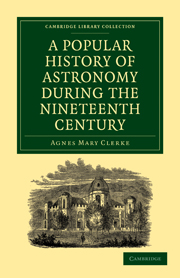Book contents
- Frontmatter
- PREFACE
- Contents
- INTRODUCTION
- Part I PROGRESS OF ASTRONOMY DURING THE FIRST HALF OF THE NINETEENTH CENTURY
- Part II RECENT PROGRESS OF ASTRONOMY
- CHAPTER I FOUNDATION OF ASTRONOMICAL PHYSICS
- CHAPTER II SOLAR OBSERVATIONS AND THEORIES
- CHAPTER III RECENT SOLAR ECLIPSES
- CHAPTER IV SPECTROSCOPIC WORK ON THE SUN
- CHAPTER V TEMPERATURE OF THE SUN
- CHAPTER VI THE SUN'S DISTANCE
- CHAPTER VII PLANETS AND SATELLITES
- CHAPTER VIII PLANETS AND SATELLITES (continued)
- CHAPTER IX THEORIES OF PLANETARY EVOLUTION
- CHAPTER X RECENT COMETS
- CHAPTER XI RECENT COMETS (continued)
- CHAPTER XII STARS AND NEBULÆ
- CHAPTER XIII METHODS OF RESEARCH
- INDEX
CHAPTER VIII - PLANETS AND SATELLITES (continued)
Published online by Cambridge University Press: 07 September 2011
- Frontmatter
- PREFACE
- Contents
- INTRODUCTION
- Part I PROGRESS OF ASTRONOMY DURING THE FIRST HALF OF THE NINETEENTH CENTURY
- Part II RECENT PROGRESS OF ASTRONOMY
- CHAPTER I FOUNDATION OF ASTRONOMICAL PHYSICS
- CHAPTER II SOLAR OBSERVATIONS AND THEORIES
- CHAPTER III RECENT SOLAR ECLIPSES
- CHAPTER IV SPECTROSCOPIC WORK ON THE SUN
- CHAPTER V TEMPERATURE OF THE SUN
- CHAPTER VI THE SUN'S DISTANCE
- CHAPTER VII PLANETS AND SATELLITES
- CHAPTER VIII PLANETS AND SATELLITES (continued)
- CHAPTER IX THEORIES OF PLANETARY EVOLUTION
- CHAPTER X RECENT COMETS
- CHAPTER XI RECENT COMETS (continued)
- CHAPTER XII STARS AND NEBULÆ
- CHAPTER XIII METHODS OF RESEARCH
- INDEX
Summary
“The analogy between Mars and the earth is perhaps by far the greatest in the whole solar system.” So Herschel wrote in 1783, and so it may safely be repeated to-day, after an additional hundred years of scrutiny. This circumstance lends a particular interest to inquiries into the physical habitudes of our exterior planetary neighbour.
Fontana was the first to catch glimpses, at Naples in 1636 and 1638, of dusky stains on the ruddy disc of Mars. They were next seen by Hooke and Cassini in 1666, and this time with sufficient distinctness to serve as indexes to the planet's rotation, determined by the latter as taking place in a period of twenty-four hours forty minutes. Increased confidence was given to this result through Maraldi's precise verification of it in 1719. Amongst the spots observed by him, he distinguished two as stable in position, though variable in size. They were of a peculiar character, showing as bright patches round the poles, and had already been noticed during sixty years back. A current conjecture of their snowy nature obtained validity when Herschel connected their fluctuations in extent with the progress of the Martian seasons. It was hard to resist the inference of frozen precipitations when once it was clearly perceived that the shining polar zones did actually diminish alternately and grow with the alternations of summer and winter in the corresponding hemisphere.
- Type
- Chapter
- Information
- A Popular History of Astronomy During the Nineteenth Century , pp. 319 - 347Publisher: Cambridge University PressPrint publication year: 2010First published in: 1885



